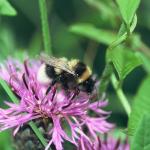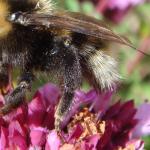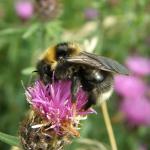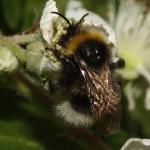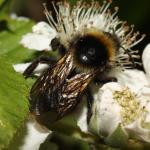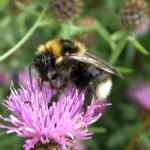Apis saltuum PANZER 1801; Psithyrus vestalis var. leucoproctus LEPELETIER 1832; Bombus varians SEIDL 1838;
Keys and general biology are found in Sladen (1912), Free & Butler (1959), Alford (1975) and Prŷs-Jones & Corbet (1991). Until recently this species was known as Psithyrus barbutellus, but Psithyrus has now been reduced to a sub-genus within Bombus. It bears a close resemblance to its host, Bombus hortorum, but has an almost circular face, most unlike the very elongated one of B. hortorum.
This species is distributed widely throughout most of the area covered by this Atlas, but is rarely common. It is widespread in Europe; middle and northern latitudes of Asia, and eastwards to Mongolia (Løken 1973).
This bee is not regarded as being scarce or threatened.
This cuckoo-bee occurs in a wide variety of habitats.
Over-wintered females can be found from late April onwards, males and new females in July to September.
During spring the over-wintered, fertilised female B. barbutellus searches for a small nest of the host bumblebee, B. hortorum. It enters the nest and eventually dominates, or kills the host queen. The parasite female then lays eggs which will develop into either males or females of B. barbutellus. All foraging and nest duties are carried out by the host workers. It is likely that this species will also attack B. ruderatus.
Visits are made to a wide variety of flowers.
None specifically recorded in Britain or Ireland.
Profile written:
Proofed: February 2012


